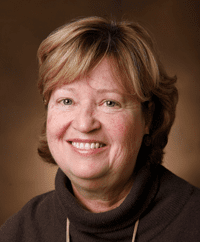Posted By: Sara Cullinan, PhD, Deputy Editor, AJHG
Each month, the editors of The American Journal of Human Genetics interview an author of a recently published paper. This month we check in with Nancy Cox to discuss her paper “GRIK5 Genetically Regulated Expression Associated with Eye and Vascular Phenomes: Discovery through Iteration among Biobanks, Electronic Health Records, and Zebrafish.”

AJHG: What prompted you to start working on this project?
Nancy: I presented some of the preliminary studies from this work at a work-in-progress meeting at Vanderbilt, and Ela Knapik, who directs the zebrafish core here, saw the presentation and asked the question at the end, “Why don’t you knock out GRIK5 in zebrafish?” And so we talked afterward and agreed to collaborate on this project. I expected it to take forever — I was totally unprepared for how rapid CRISPR can be. But it has been a fantastic collaboration and we are working together on several additional really fun projects now.
AJHG: What about this paper/project most excites you?
Nancy: Trying to understand how polygenic contributions to disease work is challenging because the effect sizes for any individual variant are quite small. This was a different kind of discovery because we had used a gene-based method and found associations to a pattern of phenotypes, not just a single diagnosis. I think that helped to us to focus the follow-up to the zebrafish studies more broadly and think about how we might test for a relationship between vascular development and eye disease.
AJHG: Thinking about the bigger picture, what implications do you see from this work for the larger human genetics community?
Nancy: I hope that people will begin to think more seriously about using very large-scale phenome information from electronic health records as an adjunct to genetic studies, which we can afford to do in only smaller numbers of individuals. The biobank at Vanderbilt is big — 250,000 subjects, but there are many more (millions) with quality phenome information but no DNA. Finding ways to use both should stretch our ability to make and extend discoveries.
AJHG: What advice do you have for trainees/young scientists?
Nancy: One of my mentors used to remind me on a regular basis that there is no shortage of interesting things to do in science — things that are so interesting they are hard to resist. But only a subset of those things are also important with respect to bigger picture questions or implications for other parts of biology. You have to continually ask yourself whether what you are doing is both interesting and important to insure that you are able to continue, and be funded, to do research that you find irresistible.
AJHG: And for fun, tell us something about your life outside of the lab.
Nancy: I really love the music scene in Nashville! It is amazingly diverse, and we take advantage of the opportunities to hear great music every chance we get.
Nancy Cox, PhD, is Director, Vanderbilt Genetics Institute; Professor of Medicine, Division of Genetic Medicine; Director, Division of Genetic Medicine; and Mary Phillips Edmonds Gray Professor of Genetics at Vanderbilt University. She was the ASHG President in 2017.
